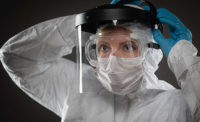Product Focus | Tools
Tools of the trade for a butcher
Butcher training covers safety, yield and repetition

“Your knives are your paintbrush, your sculpting tool,” says Kari Underly, principal, Range Meat Academy, based in Chicago. Their medium may be different, but butchers also use handheld tools like artists to bring shape to an undefined surface. To create their art, however, butchers are first taught practical skills for safety, yield and maintenance.
Most butchers are taught through school programs – high school, university or technological schools, on the job or through a training program, says Chris Fuller, director of business development, Stock Yards Southern California.
“I’ve worked with some young people who learned how to be a butcher in high school, although that’s rare,” says Fuller. “Most get hired and learn safety protocols and skills on the job.”
The Range Academy is an online vocational trade school which offers 41 courses in its meat cutting curriculum, including safety, your partner’s safety (such as how not to hit them while cutting) and where to store your knives to prevent injuries.
“Whenever we can include videos of real-world examples, we do,” says Underly.
Selecting the right tool
Safety comes first, because there are many ways butchers can hurt themselves (and others).
“They are taught how to be safe with whatever tool they are using,” says Fuller. “Then, they can learn high-level skills such as how to cut portion sizes specific to customer requests and improve yield.”
Next, it’s all about repetition, so they can get faster with each tool, says Fuller.
“Because our students are relatively new, if you put a large piece of meat in front of them, they will want to hack at it,” says Underly. “It’s important to teach them how to use hand tools right – how to take their time and use the tools, not might.”
A 400-pound piece of meat is full of bones, cartilage, joints, fat and heavy connective tissue. So, butchers need to learn the right tool to use and when to use it.
“With New York strip steak, for example, we suggest using a 12- to 14-inch long knife to cut first; then it’s easier on the butcher’s body because the tool does the work,” says Underly. “It’s all about the preservation of your body.”
Using the wrong tool can cause both frustration and injury, notes Fuller.
Taking ownership of knife maintenance
Butchers keep their knives sharp by using an outside service or are responsible for sharpening them. For the bigger tools, like saws with fine teeth, they are replaced every few days. “They aren’t expensive to replace, so most businesses don’t see the value in sharpening them,” says Fuller.
Butchers can sharpen their knives with an individual steel sharpener, band grinder or oilstone, says Underly.
“The one thing for me is, if allowed, workers should be able to take their knives home – although it opens the company up to food safety obstacles,” says Underly. “If butchers can take ownership of their knives and training, it helps them have more empowerment.”
If butchers take their knives home, they will have to follow their company’s HACCP plan to rinse, wash and sanitize their knives.
Underly suggests giving butchers their own personalized knife set and “knife sterilizer box” to place dirty knives in with water and a coil to keep the water hot. “Bone fragments dull knives, so the box keeps them clean, prevents contamination and injury and is not that expensive,” says Underly. “I really like them as another helpful tool.”
Preventing injuries
Knife and tool storage is another critical component of safety. Employees need a safe place to put their tools while working. It’s easy to image a scenario where a butcher puts a knife down (in the meat) to pick up another tool, comes back to the carcass, forgets the knife in the meat, and gets cut by the first knife while working on a new cut.
“The number one injury to butchers is getting cut by their own knife that’s buried in the meat,” says Underly. “They need a plan or safe place to put their tools. Also, they should be wearing cut-resistant gloves and arm sleeves. These kinds of things are obvious but have to be said.”
Although automation and robotics are making their way into some aspects of meat slaughter and butchering, the butcher isn’t going anywhere.
“No matter how far technology goes, there will always be a need for knives and hand tools for butchering,” says Fuller.
Diana Clark, Certified Angus Beef meat scientist, leads a butchering workshop at the brand’s Wooster, Ohio headquarters. IP
Looking for a reprint of this article?
From high-res PDFs to custom plaques, order your copy today!









